教你学术论文毕业论文的写作教程academicpaper
教你学术论文 毕业论文的写作教程 3
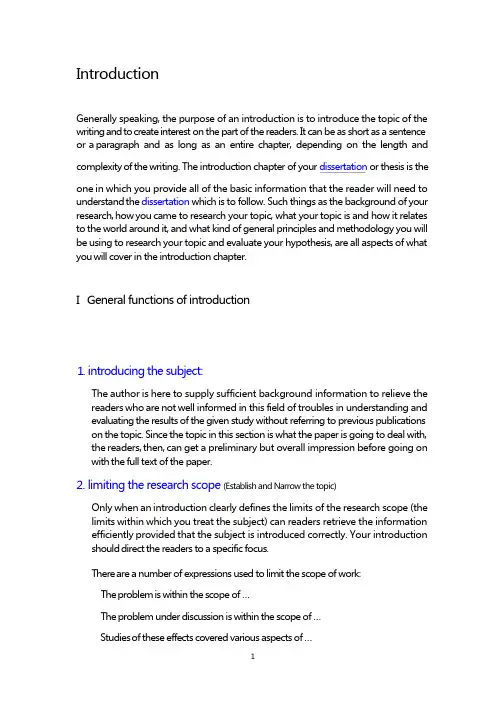
IntroductionGenerally speaking, the purpose of an introduction is to introduce the topic of the writing and to create interest on the part of the readers. It can be as short as a sentence or a paragraph and as long as an entire chapter, depending on the length andcomplexity of the writing. The introduction chapter of your dissertation or thesis is theone in which you provide all of the basic information that the reader will need to understand the dissertation which is to follow. Such things as the background of your research, how you came to research your topic, what your topic is and how it relates to the world around it, and what kind of general principles and methodology you will be using to research your topic and evaluate your hypothesis, are all aspects of what you will cover in the introduction chapter.I General functions of introduction1. introducing the subject:The author is here to supply sufficient background information to relieve the readers who are not well informed in this field of troubles in understanding and evaluating the results of the given study without referring to previous publications on the topic. Since the topic in this section is what the paper is going to deal with, the readers, then, can get a preliminary but overall impression before going on with the full text of the paper.2. limiting the research scope (Establish and Narrow the topic)Only when an introduction clearly defines the limits of the research scope (the limits within which you treat the subject) can readers retrieve the information efficiently provided that the subject is introduced correctly. Your introduction should direct the readers to a specific focus.There are a number of expressions used to limit the scope of work:The problem is within the scope of …The problem under discussion is within the scope of …Studies of these effects covered various aspects of …Our studies with this technique are confined to only one particular aspect …The problem described previously was directed to the example of…, which differsfrom …The subject is concerned chiefly with the study of …The author has limited his studies to the related aspects of …The approach under study is only applied to …The problem I have referred tofalls within thefield of …The theory cannot apply to other cases of …The emphasis of this paper is to survey …3. stating the general purposeThe task is to inform the reader of the general purpose of the paper and illustrate the primary objectives of his research. To start writing your introduction chapter, come up with a simple one sentence summary of the goal of your research. The reader will come to the first chapter of your thesis expecting a statement of purpose. This statement should tell the reader what the topic of the research paper is and what you hope to achieve.4. showing the writing arrangementThe logical arrangement of the writing enables the reader to understand the paper more easily when further reading is necessary. The best place for this information can be found at the end of the introduction.It is supposed to give the reader a sense of how the dissertation will be organized. Provide some kind of chapter by chapter breakdown to tell the reader what can be expected so that the reader will be able to scan the paper at first and have a good sense of what ended up happening. Use solid principles of organization throughout your paper, in addition to hitting all the above topics in your introductory paragraph, to make your dissertation as readable as possible.Expressions used to indicate the organization of the information include:This paper is divided intofive major sections asfollows …Sections one of this paper opens with …Section three develops the second hypotheses on …In this paper, data and results are presented under the major heading of …Sectionfour shows (introduces, reveals, treats, deals with, develops, etc) …The result of… is given in the last sectio n.Thefifth section provides an exposition that places the primary emphasis on …In thefollowing, a wide range of test data are reported …II. Structural features of introduction and some idiomatic expressions 1. starting with the research background (Literature review)To orient the reader, the pertinent(related) literature(文献) should be reviewed in writing a professional paper. The research background is usually given in the section of introduction accompanied by the recent development in this field. That is to answer the question“what have been done? ”You can talk about the background of the project. How did you choose the project? What kind of greater historical context does the research that you are engaged in exist within? You may want to talk about any related experiments or research that specific people have done in the past, including landmark research cases which are related to the topic at hand. This gives the reader a sense of how your research fits into the greater scheme of things, and lets the reader compare what you are about to present to the research which they may or may not already be familiar with from leading figures in the history of the field.Some expressions used to introduce the background of the subject in an introduction are:Over the past several decades, …Somebody reported …The previous work on … has indicated tha t …Recent experiments by … have suggeste d …In most studies of…, … has been emphasized with attention being given to …Industrial use of… is becoming increasingly common.There have been afew studies highlighting …It is well known that …2. transiting to the existing problem (investigation needed/gap )Authors usually transit to the main problem to be discussed or weak points remaining in the previous work to be further studied and/or improved. That is to answer the question“what have not been done? ”The following are expressions often used to present existing problems:Great progress has been made in thisfield, but (however, nevertheless, etc.) …Also, the consideration of … alone cannot explain the observedfact that …A part of the explanation could lie in … however, …The study of… gives rise to two main difficulties: one is …, the other i s …Despite the recent progress reviewed in …, there is no generally accepted theory concerning …From the above discussion, it appears that at present neither … nor … are known.Sofar there is not enough convincing evidence showing …The data available in literaturefailed to prove that …The theory of… did not explain how much modifications aros e.No direct outcome was then reported in …Until now, not any experiment in this area has suggested that …Until now, nofield experiments of … have been reported.No clear advancement has sofar been seen in …The methods we use differs greatlyfrom the one reported ten years ago.3. focusing on the present research (Purpose /value of your research)On the basis of reviewing the previous research, especially unfolding or displaying the weak points of the previous work to be overcome or existing problems to be solved, the author may gradually and naturally turn the reader’s attention to the present research, by stating his primary research objectives, novel ideas, advanced methods, new materials, fresh factors, etc. that is to answer the question“what am I going to d o? ”Now tell the reader what your hypothesis is, as well as your basic reasons for believing in the hypothesis. How does your knowledge of the reality of the field make you lean towards one hypothesis or another? Explain to the reader how you will be able to prove or disprove the hypothesis that you set out with through the course of your research. Talk about any particular relevant issues that could affect the course of the research, or any basic questions or problems that people might have regarding the topic and how you will go about your research process. Try to anticipate how people will react to your hypothesis and make sure that you are able to start your project on a strong heading. It may be best to have the opening paragraph of your thesis reviewed before you embark on the research process, to make sure that you are on the right track (or at least that the track makes sense to others) before you set off and put a lot of effort into collecting data.Expressions to be used to introduce the present work:In this paper, … is investigated(studied, discussed, presented, etc.)The present work deals mainly with …We repot here … in the presence of…This paper reports on …On the basis of existing literature data, we carried out studies in an effort to …The present study will thereforefocus on …The primary goal of this research is …The purpose of this paper is …In this paper, we aim at …III. ways to begin an introductionnarrative: to begin with an anecdote or a brief story that somehow illuminates the thesis, effective in catching the reader ’s attentio n descriptive: to provide an effective lead to the discussion of the subject by explaining ,illustrating or giving a bit of backgroundpreparatory: to begin with an explanation or definition of the subject to prepare for a discussion in detail in the body of the essay inquisitive: pose provocative questions to simulate the reader ’s interestcorrective: to put a common belief or show how the subject has been misunderstoods tating a problem: begin with the statement of the problem and proceed to discuss the solutiongiving a surprising fact or statistics: to grab the reader ’s attentionusing a striking quote: to use surprising quote from a well-known book or person and lead to the discussion of the topic。
how to write a good academic paper
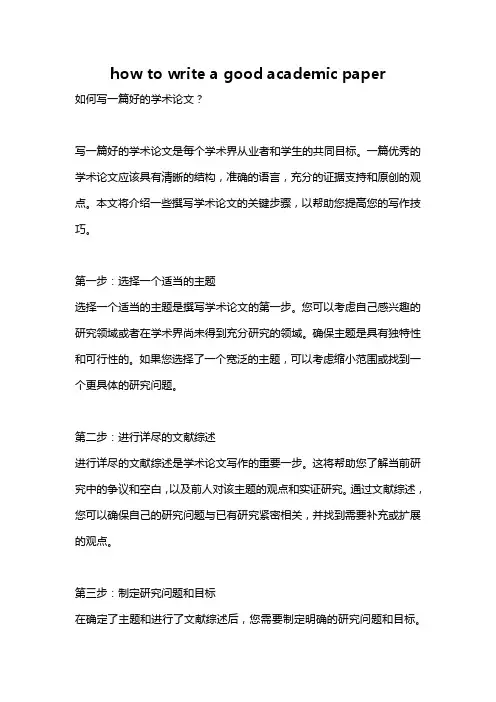
how to write a good academic paper如何写一篇好的学术论文?写一篇好的学术论文是每个学术界从业者和学生的共同目标。
一篇优秀的学术论文应该具有清晰的结构,准确的语言,充分的证据支持和原创的观点。
本文将介绍一些撰写学术论文的关键步骤,以帮助您提高您的写作技巧。
第一步:选择一个适当的主题选择一个适当的主题是撰写学术论文的第一步。
您可以考虑自己感兴趣的研究领域或者在学术界尚未得到充分研究的领域。
确保主题是具有独特性和可行性的。
如果您选择了一个宽泛的主题,可以考虑缩小范围或找到一个更具体的研究问题。
第二步:进行详尽的文献综述进行详尽的文献综述是学术论文写作的重要一步。
这将帮助您了解当前研究中的争议和空白,以及前人对该主题的观点和实证研究。
通过文献综述,您可以确保自己的研究问题与已有研究紧密相关,并找到需要补充或扩展的观点。
第三步:制定研究问题和目标在确定了主题和进行了文献综述后,您需要制定明确的研究问题和目标。
一个好的研究问题应该具有明确性,可以通过可行的研究方法解决,并且可以为学术界或实践者提供新的见解。
第四步:设计合适的研究方法设计合适的研究方法是一篇好的学术论文的关键。
您需要选择和阐述您的研究方法,以确保您可以回答您的研究问题,并获得准确和可靠的结果。
您的研究方法可以采用定性研究方法或定量研究方法,也可以结合两者,具体取决于您的研究问题和研究对象。
第五步:收集和分析数据在您完成研究方法设计后,您需要收集并分析相关数据。
收集数据的方法可能包括实地调查、实验、访谈或文献研究。
根据您的研究方法和研究目标,您可以使用不同的数据分析方法,如统计分析、内容分析、主题分析等。
第六步:撰写论文的各个部分一篇好的学术论文通常包括引言、文献综述、方法、结果、讨论和结论等部分。
在撰写论文的各个部分时,您应该注意以下几点:引言部分:引言应该饱含背景知识,引出研究问题和目标,并概述本文的结构。
教你学术论文 毕业论文的写作教程 2.graduation paper
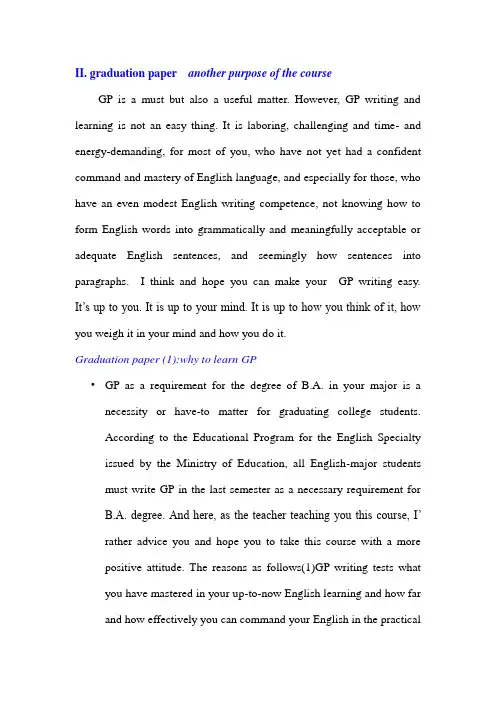
II. graduation paper another purpose of the courseGP is a must but also a useful matter. However, GP writing and learning is not an easy thing. It is laboring, challenging and time- and energy-demanding, for most of you, who have not yet had a confident command and mastery of English language, and especially for those, who have an even modest English writing competence, not knowing how to form English words into grammatically and meaningfully acceptable or adequate English sentences, and seemingly how sentences into paragraphs. I think and hope you can make your GP writing easy. It’s up to you. It is up to your mind. It is up to how you think of it, how you weigh it in your mind and how you do it.Graduation paper (1):why to learn GP•GP as a requirement for the degree of B.A. in your major is a necessity or have-to matter for graduating college students.According to the Educational Program for the English Specialty issued by the Ministry of Education, all English-major students must write GP in the last semester as a necessary requirement forB.A. degree. And here, as the teacher teaching you this course, I’rather advice you and hope you to take this course with a more positive attitude. The reasons as follows(1)GP writing tests what you have mastered in your up-to-now English learning and how far and how effectively you can command your English in the practicalregister. (2) GP writing is learning English itself, in which it enhances and reinforces your English knowledge and ability, vocabulary, grammar, especially your English writing ability. (3) Gp writing helps you to enter into a learning field.Graduation paper(2):what special with GP•GP is a a special form of RP characterized by being scholarly, scientific and original to the greatest extent possible. Scholarly: more or less theoretical and concerned with academic matters; the subject and conclusion are academically significant, and language standard and appropriate; scientific: based on scientific theories and objective data, and the problem is approached with scientific attitude and methodology; original: new perspective or method, new arguments or conclusion or even a breakthrough in a certain field.•GP is usually to be written in 3,500 to 5,000 English words. Graduation paper(3):characteristics of good GP•Gramatic adequacy: grammar adequacy is the first thing for GP.However, good GP is not good grammar or vice versa.•Unity: all parts or element of the writing constituting an organic and harmonious whole•Coherence: all parts or elements well connected to show clear logical ( deductive, inductive, causal, contrastive, hierarchical,parallel, etc.) relations.•Emphasis: special and significant stress given to important idea as by means of position, repetition, or other indication.•Development: adequate elaboration and sufficient expansion.•Clarity: precise, concise, and lucid in style.•Neat appearance and Format ( APA and MLA two styles in Am.)a brief for good GP writing: good GP calls for critical reading, critical thinking and critical revision.。
论文写作2(Academic Paper Writing)
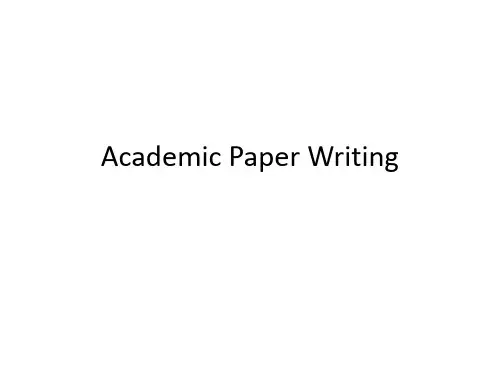
relation of equivalence.
ST≈TT or
TT≈ST
This is an approach that has close links with
contrastive linguistics and puts language system
rather than texts on either side of the relation:
We define research broadly as a systematic investigation towards increasing the sum of knowledge. Innovation is vital if a discipline is to grow and prosper.
These models are attempts to construct images of the object of study, images that hopefully make it easier to visualize, understand and analyse. In your own research project, you might take a ready model and simply use its framework and concepts unchanged or you might adapt a given model to your own purposes. Translation Studies has traditionally used three basic types of models.
• Comparative Models
The earliest theoretical model of translation was
英语学术论文写作教程-Unit 2

Unit 2 Introduction
Overview
A good beginning is half done, so is a research paper. One is to arouse the readers’ interest, and the other is to offer adequate information to prepare readers for understanding the paper and evaluating the worth of the study. In terms of structure, a well-organized Introduction presents a funnel shape, or in other words, it begins with stating general research scope and then narrows down to the research focus. In order to write an effective Introduction, Swales & Feak (2012) proposes a widely used discourse pattern, known as the Create-a-Research-Space (or CARS) model.
Information Convention
❶With the rapid development of chemical industry, heavy metals in environment increase rapidly and go beyond the normal range, which has seriously polluted the soil. ❷ Such soil contamination leads to deterioration of environmental quality and does harm to human’s health. ❸ So, it is important to control soil pollution caused by heavy metals.
英文学术论文写作方法
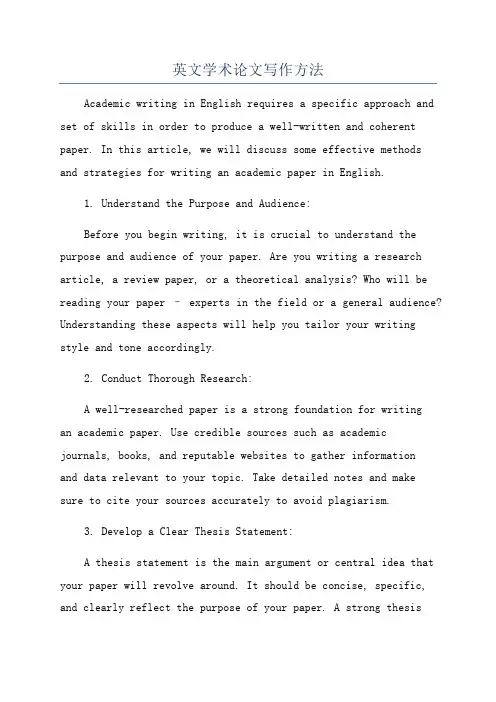
英文学术论文写作方法Academic writing in English requires a specific approach and set of skills in order to produce a well-written and coherent paper. In this article, we will discuss some effective methods and strategies for writing an academic paper in English.1. Understand the Purpose and Audience:Before you begin writing, it is crucial to understand the purpose and audience of your paper. Are you writing a research article, a review paper, or a theoretical analysis? Who will be reading your paper – experts in the field or a general audience? Understanding these aspects will help you tailor your writing style and tone accordingly.2. Conduct Thorough Research:A well-researched paper is a strong foundation for writingan academic paper. Use credible sources such as academic journals, books, and reputable websites to gather informationand data relevant to your topic. Take detailed notes and make sure to cite your sources accurately to avoid plagiarism.3. Develop a Clear Thesis Statement:A thesis statement is the main argument or central idea that your paper will revolve around. It should be concise, specific, and clearly reflect the purpose of your paper. A strong thesisstatement guides the reader and provides a roadmap for your paper.4. Create an Outline:An outline is a helpful tool to organize your thoughts and ensure a logical flow of ideas in your paper. Divide your paper into sections or subsections and outline the main points you want to address in each section. This will help you stay focused and avoid digressing from your main argument.5. Write Clear and Coherent Sentences:Academic writing should be clear, concise, and free of ambiguity. Use simple and direct language, and avoid jargon or technical terms that may confuse the reader. Each sentence should convey a specific idea or piece of information, and paragraphs should be well-structured and coherent.6. Support Your Arguments with Evidence:An academic paper should be supported by evidence, whether it is empirical data, examples, or citations from otherscholarly work. Use appropriate referencing styles such as APA or MLA to cite your sources accurately and give credit to the original authors.7. Revise and Edit:8. Pay Attention to Style and Formatting:Follow the guidelines provided by your institution or journal in terms of formatting and citation style. Pay attention to details such as font size, margins, spacing, and citation requirements. Consistency in style is key to maintaining a professional and polished paper.9. Proofread Your Final Draft:Finally, carefully proofread your final draft before submitting it. Look for any typos, grammatical errors, or formatting inconsistencies. It may be helpful to read your paper backwards, starting from the last sentence, to focus solely on the language and not get caught up in the content.In conclusion, academic writing in English requires a systematic and organized approach. By understanding the purpose and audience, conducting thorough research, developing a clear thesis statement, and following the proper structure and style, you can produce a well-written and effective academic paper. Remember to revise, edit, and proofread your work to ensure a polished final product.。
WritingaCollegePaper-如何撰写大学论文?怎么写大学
Writing a College Paper-如何撰写大学论文?怎么写大学Chapter II Literature Review 1 文献回顾部分必须要有一定量的文献做佐证支持文章并且大多数应是英文文献,您只选用了9个文献且采用中文文献较多,肯定过不了关,英文文献最少也要有20个左右。
2 第二章文献回顾除去文后的reference list才一千多字,这部分的字数要求是2500字,请扩充文章内容,否则论文连及格都很困难。
3、我发现文章中有些内容和我之前送去学校进行语法修改的那篇旧的文献回顾草稿的内容是一样的,但您并没有参考语法修改后的结果,我不明白这是为什么,我已用黄笔帮您标出语法进行调整的地方了,再次提醒您以后注意语法问题 4、请注意调整第二章文献回顾与第一章introduction重复出现的语句. 5、我对这部分的有些内容我做了一点调整,请您看看这样行吗? 6、书籍要有页码、出版商,期刊要有页码, vol, issue, no,电子期刊于要有代码。
2.1 of literature reviewThis chapter reviews relevant literature. It reviews the research related to Mary Kay's direct marketing activities; and reviews relevant investigations on the impact of Chinese culture on Mary Kay’s promotional strategy. In addition, it reviews studies on the role of Chinese women in relation to the cosmetics market andcompany strategy. It then reviews studies on the problems existing in Mary Kay’s promotional strategy and summarises of the meaning and innovations of this cha Researches on Mary Kay’s promotional strategyMary Ka y's success has attracted much research interact; Ash 1995:67 proposed that Mary Kay's success is due to the fact that their choice of the promotional strategy is suitable: direct selling. In July 1998, Mary Kay became the first professional cosmetics company to obtain the approval and recognition of relevant government departments, which make Mary Kay take the adoption of their core philosophy of direct sales. The continuous refinement of direct selling over the last 45 years enables it’s marketing to br ing direct benefits to it.In China, Mary Kay take some special services for promotion, the most important is to provide professional beauty consultants to customers. Every Mary Kay beauty consultants and distributors 有必要在这解释下distributors是什么 can develop new beauty consultants to join in Mary Kay, but each new employee must start basically as beauty a consultant, selling products mainly and supplementing consultant’s assistant 到底是美容顾问还是顾问的助手is a new approach to develop是指帮公司发展吗. Mary Kay use incentive-style to train employees, when you join in Mary Kay,there will be a series of free training, each made a little success, such as weekly, monthly, quarterly sales charts这是什么,这似乎不是前半句说的free training的一部分内容吧, etc. will be the company's incentives, such as symbolic pins, jewelry and so on Roche, Imelda,1995 . When the monthly sales of products and the development of new beauty consultants achieve a certain amount, a new beauty consultant could be become a distributor in nine months as early as he can. After becoming a distributor, it means you formally entered the ranks of managers and can be separated from the original dealer to form their own beauty consultant team, which is equivalent to its own separate registration of a small company. Meanwhile, the company continues to provide free training for each employee, and there will be a fixed income. To become a distributor is the goal of every beauty consultant.Ash 1995:46 thought that the corporate culture of Mary Kay was also an effective marketing tool, because the company was committed to provide women with more opportunities forself-realization, it also indirectly enhanced the female consumers’ impression for this company, which enabled more women consumers pay more attention to this company so as to accept their products, it also the key for the enterprise toachieve a success. The secret of Mary Kay’s success has been its unique approach to business; both in philosophy and business strategy Raymond, Mary Anne and John F. Tanner, Jr, 1994 .The above figures show the operation in the marketing strategy. The company has made achievements, as a result of using direct marketing and other promotional strategies to promote the development and growth of the com The impact of Chinese culture on Mary Kay’s promotional strategyChina is a society which pays much attention to relationship between people; the so-called ‘relationship’ in China usually refers to some ways which connect two people together to establish an interdependent link Sun Xiaohong,。
英语学术论文写作学术论文的写作要求及写作方法
英语学术论文写作学术论文的写作要求及写作方法Academic paper writing is an essential skill that every student and researcher should possess. It allows individuals to explore specific topics, present their findings, and contributeto the expansion of knowledge in their field of study. Thisarticle will discuss the requirements and methods of writing an academic paper.1. Requirements of Academic Paper Writing:a. Clarity and coherence: A good academic paper should be clear, well-organized, and easy to understand. The writer should present their arguments and ideas in a logical and coherent manner to guide readers through the paper.b. Research-based: An academic paper should be grounded in extensive research. This involves conducting a literature review, gathering data, and analyzing relevant sources to support the arguments made throughout the paper.c. Originality and contribution: A strong academic paper should present novel insights or contribute to existing knowledge. It should offer a unique perspective or provide additional evidence to enhance the understanding of the topic.d. Proper citation and referencing: To maintain academic integrity, all sources used in the paper must be properly cited.This prevents plagiarism and allows readers to verify the information presented.e. Structure and format: Academic papers typically follow a specific structure, including an introduction, literature review, methodology, results, discussion, and conclusion. Adhering tothis structure helps readers navigate through the paper more effectively.2. Methods of Academic Paper Writing:a. Identify a research question: Begin by choosing aresearch question or topic that is interesting and relevant to your field of study. Make sure the research question is specific and focused, allowing for in-depth exploration.c. Develop an outline: Create a clear outline that organizes your thoughts and ideas. This helps maintain a logical flow and ensures that all essential points are addressed.e. Present your methodology and research findings: Clearly explain the methodology used for your study and present your findings. Use graphs, tables, and other visuals to enhance the presentation of data.f. Analyze your results and discuss their implications: Interpret and analyze your research findings, discussing their implications in relation to previous studies. Identify any limitations or further areas of research.g. Write a concise conclusion: Summarize your main findings and highlight their significance. Avoid introducing new information in the conclusion.h. Revise and edit: Proofread your paper for grammar, spelling, and punctuation errors. Ensure that your ideas flow smoothly and logically.i. Cite your sources properly: Use the appropriate citation style (such as APA, MLA, or Chicago) to reference your sources accurately throughout the paper.In conclusion, writing an academic paper requires clarity, research-based content, originality, proper citation, and adherence to a defined structure. By following these requirements and methods, students and researchers can effectively contribute to their field of study and advance knowledge in their chosen area.。
教你学术论文毕业论文的写作教程anabstract
Questions on the Abstract•What is the subject matter/area the research paper is dealing with?•What background information is provided by the author(s)?•What is the purpose of the present study?•How is the research to be done?•What are some of the important findings?•What are some of the implications of the study?Elements of structure in an Abstract•We can see that by asking a number of questions we can discover the structure of the Abstract.•We can refer to each section as an "element of stmcture"・ Tlie six elements of structure can then be refeiTed to as•Topic Specification (TS),•Background Information (BI),•Purpose Statement (PS),•Methodology and Data (MD),•Results/Findings (RF), and•Implications/Conclusions (IC).•An important issue here is the time for the writing of the Abstract・•Usually it is written after the study/research is completed but this is not always the case as, for example, people send abstracts of unfinishedpapers to conferences they would like to participate in.•Such abstracts are not totally different from those written for finished papers; they may include less information in some parts like in theResults and Implications sections・Information content of Abstracts•An obvious conclusion to be made at the beginning is that Abstracts are short pieces of writing・•Of course we can have long and short Abstracts but that is beside the point.•The information in an Abstract is condensed because of the summarizing nature of the Abstract・•There is no redundant information in an Abstract・•Getting rid of the redundancy in the Abstracts, however, is not always easy to achieve・Structure of an Abstract•An Abstract of a research paper is the first source of information for a would-be reade匚•Of course the title of the research paper would provide information about the topic of investigation but it is the Abstract that provides a bird^s eye view of the subject matter, the pmpose of the study, the way the research is carried out, some important findings, the implications, and a conclusion.• The Abstract summarizes the study for people who would like to spend no more than a few minutes on the pape匚Sample AbstractTitle: Analyzing Bush's Remarks to the Nation on the Terrorists Attacks from a Critical PerspectiveAbstract:(1) Critical discourse analysis is an important way of inteipreting rather than just describing the linguistic structure of texts. (2) It aims to reveal the relationship between language and ideology・(3) One of the great events that happened in the year 2001 is [was that] the U.S.A. was attacked on September 11th・(4) Right after the attack, President George Bush delivered a speech to the nation. (5) The New York Times ported [reported] his address on Sep, 12th.(6) Tliis paper tries to analyze Bush,s remarks from a critical perspective, focusing on revealing the hidden ideology of the American government.Sample Abstract2On Textual Equivalence of English-Chinese Translation in the Light of Theme/Rheme Theory(1) Translations "refer to the process and result of transfemng a text from the source language into the target language^・(2) One of the issues of translation is the format of equivalence・(3) This light on textual equivalence based on Halliday^ theme/rheme theoiy (4) This paper consists of five parts an introduction. (5) Pail I introduces Halliday^s notion of theme and rheme, theirfunction in a message organization and the main types of theme in English. (6) Part II, with Halliday's theoiy as reference, the paper lists many examples of English-Chinese translation as far as different types of theme is concerned, and then it analyzes the choice of theme in English and the choice of topic in Chinese version. (7) Part III, based on the data analysis of theme choice in English and the topic choice in Chinese in part II, the paper tries to make clear that English and Chinese, belonging to different language systems, have different ways of organizing a message. (8) Part IV suggests some possible ways for English-Chinese translation when them in English can not be taken as topic in Chinese version.(9) Part V is the conclusion, in which the paper points out that in English-Chinese translation, in which the paper points out that in English-Chinese translation, a competent translator should decide from the receiver^ perspective what (whether the theme or not) will be placed at the topic position for Chinese audience. (10) Through the theoretical view and the empirical analysis, this paper tries to assert that in translation, at the text level, no exact equivalence can always be found. (11) A translator^ task is to transfer one language into another in a more appropriate format in the target language, on condition that the information and the style of the source language are maintained and well received by the audience of the target language.Comments•The main problem with Abstract 2 is that a lot of the information given in the second paragraph, i.e. sentences 5-9 can be omitted・•Abstracts do not usually give detailed information about the content of each section of a research pape匚•By asking the 6 questions mentioned above, we get some idea of the elements of structure in the Abstract・•However, the information needed for establishing each element has to be sifted through the additional information that could have been put in the Introduction of the same paper.•The secret of a successful Abstract is in giving the most information in the least number of words in a coherent structure. This can be achieved by reading good Abstracts and then imitating them when you need to write one.。
英语学术论文写作方法
英语学术论文写作方法Academic writing in English requires a specific set ofskills and techniques. In this article, we will discuss the methods that can help improve your academic writing. Whether you are a student or a professional in a particular field, thesetips will help you create a well-structured, clear, and concise academic paper.1. Understand the Requirements:Before you begin writing your paper, it is crucial to understand the requirements and guidelines provided by your institution or journal. These requirements may include specific formatting guidelines, citation styles, word limits, and the overall structure of the paper. Make sure you carefully read and understand these requirements to avoid any unnecessary revisions later.2. Plan Your Paper:Planning is an essential step in academic writing. It helps you organize your thoughts and ideas before you start writing. Create an outline or a mind map to arrange your main points and supporting evidence. This will help give your paper a logical flow and structure.3. Use Formal Language:4. Use Proper Citations and References:Accurately referencing the sources you have used is crucialin academic writing. Citations and references help acknowledgethe work of others and provide evidence for your own arguments. Familiarize yourself with the citation style required (such as APA, MLA, or Harvard) and follow the guidelines meticulously.5. Write Clear and Concise Sentences:6. Present Evidence and Arguments:Academic writing requires supporting your arguments with evidence. Use reputable sources such as academic journals, books, and credible websites to strengthen your arguments. Present the evidence in a logical manner, and explain how it supports your point of view. Avoid making unsupported claims or using personal anecdotes unless it is specifically allowed in the specific context.7. Revise and Edit:Once you have finished writing your paper, revise and editit carefully to improve the clarity and coherence of your ideas. Check for grammatical errors, awkward sentence structures, and spelling mistakes. Pay attention to the organization of your thoughts and ensure that each paragraph flows smoothly into the next. Seek feedback from a peer or a mentor to get an objective perspective on your writing.8. Avoid Plagiarism:Plagiarism is a serious offense in academic writing. Always give credit to the original authors and cite the sources properly. Paraphrase and summarize the ideas of others using your own words, and include proper citation to avoid unintentional plagiarism. Familiarize yourself with your institution's plagiarism policy and guidelines to ensure your work meets the required ethical standards.。
- 1、下载文档前请自行甄别文档内容的完整性,平台不提供额外的编辑、内容补充、找答案等附加服务。
- 2、"仅部分预览"的文档,不可在线预览部分如存在完整性等问题,可反馈申请退款(可完整预览的文档不适用该条件!)。
- 3、如文档侵犯您的权益,请联系客服反馈,我们会尽快为您处理(人工客服工作时间:9:00-18:30)。
General Introduction to Academic WritingL types of academic paper1. according to the purpose the paper servesa ・ term paper for a university courseb> research paper to be published in a journalc. thesis or dissertation for a university degree2. according to the content of the papera. Experience Papersb. Methodology Papersc. Opinion Papersd ・ Systems Paperse ・ Theory PapersIL Features of academic papers1. ObjectiveIt expresses the author's understanding of the topicexperiments, facts, data and analysis2. FormalThe words and structure are rather formal and rigid, widely accepted formats are the APA-foimat ( Psychological Association) and the MLA-fonnat Language Association).IIL Parts of a paper1. A research paper is usually made up of the following parts based onThe mostAmerican (Modern•Title page•Abstract•Outline (or Table of Contents. Optional. Usually placed right before or right after the abstract)•Text (introduction, body and conclusion)•Notes (optional. Sometimes figures and tables are also allowed)•Works cited ( or Bibliography)•Appendix (optional. Placement: After all the other parts) •Acknowledgements (optional. Sometimes it is placed before the abstract and sometimes at the end of a paper)2.An empiric paper frequently follows this structure:.Title•Abstract•Introduction•Methodology•Results•Discussion•Conclusion•ReferencesIV. steps in preparing a research paper1.8 steps/stages1)select topic2)explore data3)gather data4)formulate thesis5)organize data and ideas6)write paper7)review and revise8)publish2.Ten Steps to a Good Research Paper• Step 1. Choose Your Topic. When choosing a topic, choose one in which youare interested, and for which there is enough information.If your topic is too broad, you will have difficulty completing yourpaper. 'The Effects of Pollution11 is too broad because there are so many effects of pollution. H The Effects of Pollution on Geese in theNortheast Section of Duluth, Minnesota1* is too narrow. You are not likely to find much information that is this specific•”The Effects of Pollution in Yosemite National Park n is just about right as a topic.•Step 2. Locate Information. Use information from a variety of referencesources. These sources include encyclopedias, almanacs, scholarlyjournals, books, magazines, and newspapers. Find these sources in print form, on CD-ROMS, and on the Internet.•Step 3. Prepare Bibliography Cards. Prepare bibliography cards to document the sources of information you use when writing your paper. Your library will have style manuals to illustrate how to prepare bibliography cards for various sources of information.•Step 4. Prepare Note Cards. Use note cards to record notes from each source you use when writing your paper. Number your note cards to keeptrack of them.•Step 5. Prepare an Outline. Write an outline for your paper by organizing your notes from the note cards into topics, subtopics, details, andsubdetails・ Use an organization such as:•(topic)■(subtopic)■(detail)♦ (subdetail)•Step 6. Write A Rough Draft. Use your note cards and outline to write a rough draft of your pape匚As you write your draft, use numbered footnotes to credit sources from which you take quotations or major ideas・•Step 1. Revise Your Rough Draft. Make any changes needed to be sure yourideas are clearly expressed and your writing has accurate spelling andgram mar.•Step 8. Prepare Your Bibliography. At the end of your paper, provide a list of all the sources you used to gather information for the paper. Your bibliography cards will provide this information. List your sources inalphabetical order by the first word on each of your bibliography cards・•Step 9. Prepare a Title Page and Table of Contents. The title page is the first page of the pape匚It should include the title of your paper, your name, and the date on which the paper is due. The table of contents is the second page. It should list the main topics, important subtopics, and the page on which each is introduced in your pape匚•Step 10. Final Checklist. Before handing in your paper, be sure you can answer H Yes u to each of the following questions・■Did I include a title page?■Did I include a table of contents?■Did I number all pages correctly?■Did I provide footnotes for quotations and major sources of information?■Did I include a bibliography?■Did I keep a second copy for my files?。
